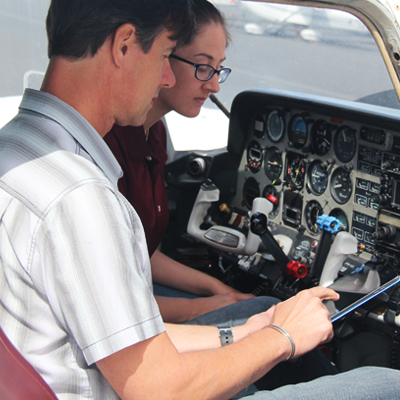Learning to Fly An Airplane


You have a number of good resources available to you to help you find a flight school or flight instructor. It's a good idea to spend some time at your local airport and speak to other pilots and student pilots and get their feedback and recommendations. Don't be afraid to ask a lot of questions and do your reasearch!
- Do internet research of flying schools in your area would be a good start as well. You'll find a list of flight schools in your home town, or nearby.
- Try searching for independent flight instructors: a good source is the National Association of Flight Instructors (www.nafinet.org), which publishes their members in a database that is searchable by state.
- You should also do a search for flying clubs in your area - we'll explain why in a minute.
- You might also consider buying an airplane - if you've got the big bucks - because aircraft manufacturers might include free flying lessons as a part of the deal.
Your Four Options
- Flight Schools
- Independent Instructors
- Flying Clubs
- Buy an Airplane
How to Choose
Interview the Candidates
Then what do you do? When you apply for a job, you have to endure an interview, or three, in order to get the job - in the same way, you need to interview the potential instructors you've selected.
You're hiring someone to sit alongside you in the close confines of an airplane for a long time. Whether it's a flight school, an independent instructor, or through a flying club, you're going to be paying a lot of money for your flight training and your instructor is the key ingredient.
Let's Go Flying
Finally, after you've selected a couple of viable candidates, ask each of them to teach you an introductory flight lesson - in some places it's called a "Discovery Flight".
Ask Them About Their Plans
Once you choose an instructor, find out about their long-term flying goals. If the instructor has plans to take a corporate job, or is hoping for an airline gig, you may have to find a new one in the midst of your training. It's a complicated process finding an instructor, but you'll be well-served when you find the instructor who best fits your needs.
For more detailed information on finding the right flight school or instructor, download our FREE eBook below.
Learning The Basics Through Solo
It is not as complicated as it seems
You need to understand the basic elements of flight before you can figure out how to land, and how to fly a cross country.
Everything Boils Down to Just Four Maneuvers
The syllabus you'll follow is designed to teach you how to control your airplane in the four basic flight maneuvers: climb, descent, straight and level, and turns. (Any maneuver, no matter how complicated it may seem, is merely a combination of those four maneuvers.)
If you've taken an introductory flight lesson, you'll already know something about climbs, descents, flying straight and level and turning. Depending on your syllabus, the second lesson will involve combining climbs and descents with turns, so that you can understand better how lift works. You may also learn about how flaps (those panels on the trailing edge of the wing that can be lowered) affect the way your airplane flies.
You'll also start learning to identify, assess, and mitigate the risks for each flight you do - something you'll continue to do throughout your flying career.
You'll expand your capabilities by...
- Learning about how slow flight will get you ready for landings
- Mastering basic airplane control
- Practicing steep turns will help polish your aircraft control
- Learning to stay in control even without engine power
- Discovering how to keep the air over the wings smooth
- Learning how to tackle the stall
- Getting those landings down
- Preparing to solo
Getting Your Medical Certificate
In order to solo, you'll have to have a medical certificate. FAA publishes a list of AME's (Aviation Medical Examiners). You can find a list of AME's with a quick internet search. The FAA website will direct you to a searchable database where you can hunt for an authorized doctor by country, county, city, zip code or last name.
When you've found a medical examiner near your home or work, you'll make an appointment.
- The AME's staff will inform you that you will need to fill out an online application on the FAA's MedXPress web page (https://medxpress.faa.gov/)
- Fill out the form, you'll be given an application number, and then present yourself to the AME at the appropriate day and time.
The examination involves a basic physical (turn your head and cough), an eye exam, a hearing test and you'll have to provide a urine sample. FAA is really interested if you have had any heart trouble, pain or neurologic disorders ... or if you take any FAA-prohibited medications that could affect your mental processes or emotional stability.
If you have any questions about medications, you should not fill in the form until you get some advice. You can get the help you need by joining Aircraft Owners and Pilots Association (AOPA). Their website is www.AOPA.org Once you're a member, look for the FAA Accepted Medications Database, or talk to a phone counselor for help with these issues.
Generally, you'd want a third class medical certificate to become a private pilot. You do not need a medical certificate to become a sport pilot. If you had a desire to get paid for your flying, you'd need a second class medical certificate. If you had airline aspirations, you'd have to pass the test for a first class medical certificate. Some people who have higher aspirations apply for the higher medical certificates just to see if they can pass the requirements. That would be a choice you'd have to make - but for basic private pilot privileges, all you need is a third class medical.
The medical examiner will issue you your medical certificate if he/she finds no problems with your exam. After you’ve obtained your first medical certificate, if you meet the requirements, you won’t even have to have any more medical certificates.
Once you've completed your long cross country flight, you'll start preparing for the checkride. You'll review all those maneuvers you learned early in your flight training. You'll practice identifying, assessing, and mitigating risk for a flight. You'll finish up any hourly requirements like instrument time, night time and solo time. You'll perform all the FAA required maneuvers.
The check ride has two parts—an oral exam and flight test.
Your Oral Exam
Prior to the actual checkride date, the examiner will assign you a cross country flight to plan. The oral consists of a discussion. You'll discuss every aspect of the flight: route planning, weather interpretation, performance numbers for your airplane, aircraft loading, any airspace along the route of flight - virtually every aspect of the cross country, including the regulations that apply. You'll also be asked to identify, assess, and mitigate the risks for the planned flight.
By the way, here's another plug for getting a good score on your knowledge exam. Let's say you and I were to take a private check ride from the same examiner. And let's say that you scored a 96 on your knowledge exam, and I scored a 73. The examiner is required to ask us the same questions. The difference is that if you give a correct answer to a particular question, the examiner will assume that you know the information. If I give a correct answer, he may assume that my answer was a lucky guess and may ask follow up questions to ensure that I really do know the answer. So... score well on your knowledge exam and you'll have an easier time with your oral.
Your Flight Test
If the examiner is happy with the results of your oral, then you'll get to go fly. Often you'll get a short break between the oral and the flight to grab a bite to eat or freshen up. (Chances are, if you scored well on your knowledge exam, your oral won't be so long that you'll need a break.)
The examiner will follow along as you pre-flight your airplane, perhaps asking questions as to why you're doing what you're doing. If you're both satisfied with the pre-flight, you'll get to do the fun part, fly the airplane. It may not prove, or re-prove, your skills throughout your flying career. Most examiners will tell you that they'll know how the ride will go in the first five minutes. They'll look for telltale signs like good radio work, taxiing on the center line of the taxiway, correcting for wind by placing your flight controls in the proper alignment for the wind, and a thorough use and understanding of the checklists.
The FAA outlines all the maneuvers you'll have to perform and the standards to which you'd be held. When the tests are complete, the examiner may ask how you thought you did. It's a good time for you to make an honest evaluation of your performance. But when you return from that ride and the examiner shakes your hand to congratulate you as the world's newest private pilot, you'll remember that moment for the rest of your life. You are now an Official Pilot!
Prepare for the Written Exam Now
Get a Head Start on Your Training
- Save money on your training
- Feel more confident in the air
- Get your license faster
King Schools Private Pilot Ground School & Test Prep Course
Eveything you'll need to ace the FAA Written Exam - Guaranteed
- Answer actual FAA Private Pilot test questions
- Fully-interactive questions
- Always up-to-date Guaranteed!
Understanding Aviation Concepts

- Aerodynamics
- Weather
- Communications & more
- Taking the FAA Knowledge Test
Ready to get started?
Talk to an Aviation Training Expert Now
800-854-1001
Not sure how to get started?
Talk to an Aviation Training Expert Now

Our Pilot Training Advisors are here to help you with your training decisions 800-854-1001
Or have a Pilot Training Advisor contact you
FREE eBook

So You Want to Learn to Fly
- Get started on the right path
- Step-by-step explanations & tips
- Make well-informed training decisions
FREE Online Course
Your First Flying Lesson
Your First Flying Lesson
If you've ever dreamed of soaring with the eagles, ever imagined yourself enjoying the freedom of flying, then you'll love this great introductory flight lesson.








